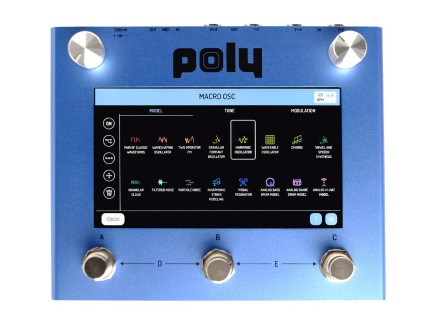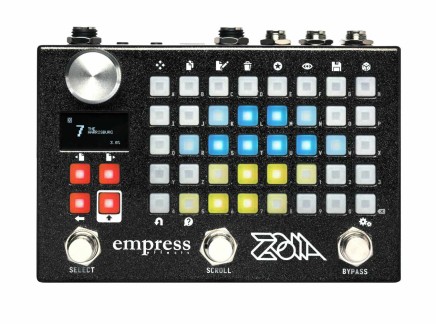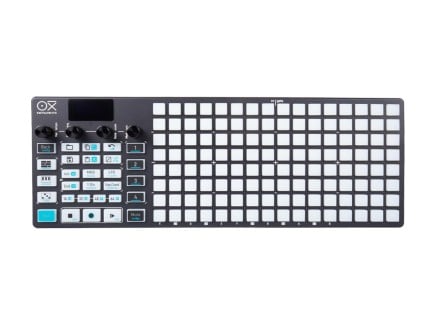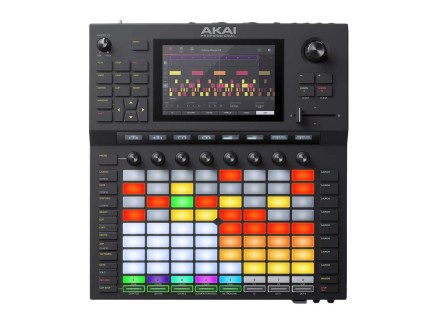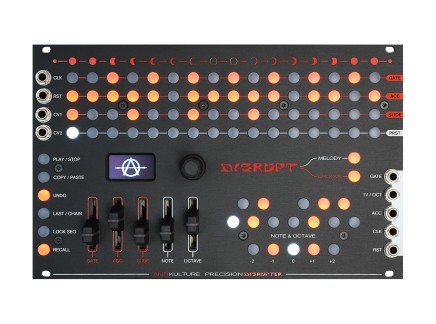2023 is soon drawing to a close—so, we're taking a look back at the year, and taking account of all of the weird and wonderful instruments that gave us some inspiration this year. Synthesizers, drum machines, and Eurorack modules to samplers and effects, this year had no shortage of inspiring instruments.
So, we reached out to some of our friends and content creators to fill us in on their year, asking one simple question: what was the coolest piece of gear you got this year? For some, that meant brand new releases, but for others, it meant sitting down and digging into classic instruments. See below for a growing list of all the weird and wild gear our friends have been digging into this year.
Round 1: Mylarmelodies, Sarah Belle Reid, Molten Music Technology, Liam Killen, and Oora
First off, we're going to hear from some truly wonderful and talented musicians: the charismatic synth reviewer Mylarmelodies; musician and educator Sarah Belle Reid; writer and musician Robin Vincent/Molten Music Technology; producer Liam Killen, and composer/sound designer Oora.
Undoubtedly an eclectic bunch, their recommendations include new Eurorack modules and effect pedals, '90s synthesizer classics, and groundbreaking controllers. Check out the video above to hear it all straight from them—and read on for our thoughts about everything they chose as their favorite gear of the year.
Mylarmelodies with a Throwback: the Nord Micro Modular
Though Nord's Micro Modular is certainly not something that was released this year, we can definitely get behind revisiting some beloved vintage gear. The Nord Modular series as a whole has long held serious love among experimental and exploratory electronic musicians, and it's easy to see why. After programming patches on the accompanying computer software, you could store them all on your Nord Modular unit and recall them on stage or in the studio as needed. And of course, in true modular synthesizer fashion, you're free to rig up all sorts of specialized patches beyond what you might find on a typical keyboard synthesizer, ranging from specialized FM patches to additive synthesizers and more.
The Micro Modular was the smallest version of the Nord Modular to be released, hitting a more affordable price point at the tradeoff of a very streamlined user interface and lighter DSP power. But that said, the Micro Modular still packed 99 preset slots and stereo audio I/O, making it a very capable platform to build out tailored patches that complement your other pieces of gear. Three onboard encoders let you tweak your patches right from the panel, though of course thanks to the inclusion of MIDI I/O this can be extended externally.
Though we're yet to see a new spin on the Nord Modular from Nord themselves, the influence of the originals on both artists and instrument designers is massive. Today we have plenty of alternatives to the Nord Modular, from software applications like VCV Rack to other '"modular-in-a-box" devices like the Empress ZOIA and Poly Effects Beebo. But at the time of its release, and even now, the Nord Modular stood out for its open-ended nature in sound and performance. That's why, so long as you have a computer compatible with its aging software editor, the Nord Modular continues to be so desirable.
Curious to hear more from Mylarmelodies? Check out his YouTube channel!
Skronkin' with Sarah Belle Reid: Fairfield Roger That
Sarah Belle Reid's pick is easily one of the most interesting effect pedals of the year: Fairfield Circuitry's Roger That. Roger That is difficult to describe—it sits somewhere within the realm of distortion or extreme fuzz, and, depending on the settings, can sound something like the wavefolding/waveshaping techniques you might find in a modular synthesizer. Regardless what you might call it, it's an outrageous and somewhat unpredictable way of turning any sound into something brutally intense and surprising.
Inspiring by the artifacts that result from malfunctioning radio technology, you can think of Roger That's sound as being somewhat similar to a broken FM or AM radio. The "Tune" knob is a lot like the process of tuning between stations. It's not a linear control that goes straight from one tone to another—instead, it is highly nonlinear, passing through many distinct states as you turn it. It interacts with the Shift control as well, in a way that makes it difficult to predict how it will sound with any given combination of settings. This might be a source of frustration for some...but if you go into it willing to embrace its unpredictability, it can be a highly rewarding tool.
Roger That features a built-in JFET drive section, multiple "tune" frequency ranges, a built-in bandpass filter, and a CV input for the Tune control—great for interfacing with modular synthesizers or semi-modular synths. In fact, turning the Tune control or modulating the Tune CV input can cause Roger That to produce sound even when nothing is plugged into its input...making it an peculiar and quite useful sound generator all on its own. Send in an LFO for evolving, sputtering cascades of sound, or send it a sequence to use it as a chaotic drum machine.
Roger That is a complex and powerful tool—so if you want to dive deeper into how it works, be sure to check out our dedicated article all about it. And of course, check out more of Sarah Belle Reid's work on her YouTube channel!
Melting Sound with Molten Music Tech: Blukać Endless Processor
One of the hottest Eurorack modules of the year, few modules have caught the attention and adoration of many modular musicians like Blukać's Endless Processor—and for good reason. There are still not many Eurorack modules devoted to the task of spectral processing or resynthesis, meaning that what the Endless Processor can offer feels like fresh sonic territory for many patchers. After a few small batches late last year selling out in a few minutes, the Endless Processor saw wider release this year to bring this novel take on infinite sustain to more racks.
The Endless Processor does exactly what it describes: feed sounds into it and tap the yellow Memory button to smear any input signal into an infinitely sustaining drone. This holds true not only with harmonic content such as raw oscillators or pads, but also with complex sources like drums, spoken word, field recordings, and more. Its dual-channel design sporting five sound layers each affords you the ability to blend and morph between resynthesized sound profiles. As a resynthesis tool, Endless Processor offers a much different sonic character compared to granular time stretching or drowning sounds in delay and reverb, and it's something that has seemed to resonate with plenty of modular folks out there.
With continued firmware updates and teasers of an expander module in the works, Blukać is going to be keeping the Endless Processor on a lot of people's minds in the years to come. Needless to say, we're looking forward to what's coming from them in the future. And of course, if you want to hear more from Robin Vincent/Molten Music Technology, be sure to check out his YouTube channel!
Taking Control: Liam Killen & the OXI One
A bevy of features, intuitive interface, and slim, portable design are just a few things that make the OXI One an outstanding musical interface. Simply calling it a controller or sequencer doesn't quite do it justice, as it can easily be the entire brains of your electronic universe complete with projects that are almost as robust as an Ableton session. The OXI One is also a living piece of equipment with firmware updates that increase functionality and address issues the user base might bring up.
If you're not familiar with the OXI One, it's a grid-based device that gives you 4 tracks of sequencing with each of those 4 tracks capable of running Mono, Poly, Chord-based, Stochastic, Multi-channel, or Matrical sequences. Each project can be saved and is capable of storing 64 patterns for each of the sequencers with an added Song Mode that lets you arrange the patterns in intricate ways. On top of the software features, you get exceptional connectability with 8 CV and Gate outputs 32 channel MIDI TRS, USB host and MIDI operation, plus Bluetooth MIDI functionality.
The Stochastic and Matrical modes are unique additions that blend generative patterns with intentional decisions making composition ideas flow easily. In Stochastic mode you choose a root and scale, then adjust the likelihood that a particular interval gets played, how fast and at which octave, too. Matrical mode is one of the more complex ones giving you 4 matrices that can be assigned to different channels and as the sequence plays out, you can set a particular square to adjust by interval, change the resolution, add rachets—it's very deep.
Whether you want to sequence complex generative patterns, or need a reliable, expansive sequencer, the OXI One is certainly not something to sleep on.
Want to hear more from Liam Killen? Check out his YouTube channel!
Making Space: Oora on the Meris MercuryX
Oora's pick is the Meris MeruryX—a groundbreaking design that builds on the sound of their Mercury7 reverb pedal and LVX modular delay system pedal. With eight custom reverb algorithms (including some from Mercury7) and a user interface/conceptual structure similar to the LVX, MercuryX is the ultimate tool for sculpting your own custom reverb tones.
Reverb algorithms include the familiar Ultraplate and Cathedra from Mercury7—each inspired by the otherworldly atmospheres of the Blade Runner soundtrack. New algorithms include the 78 Room, Plate, and Hall, each inspired by a familiar (cough, cough, Lexicon) classic reverb processor. The Spring, Prism, and Gravity structures are all-new additions dreamed up specifically for MercuryX.
But MercuryX is more than just a bunch of fancy reverb algorithms. It allows you to add processing elements like chorus, vibrato, vowel mod, tremolo, lo-fi, and more. Moreover, it allows you extensive control over internal signal routing, allowing you to customize your feedback routing, processing element placement, and more. Additionally, there are tons of ways that you can control various aspects of the effect in real time—via MIDI, assignable expression inputs, and the built-in front panel controls.
Frankly, this is much more than a reverb pedal: it's an entire platform for designing completely new, highly responsive sonic spaces. This is one of the best tools on the market—so if you take reverb seriously, check it out. And of course, if you want to dive deeper into MercuryX, check out Oora's YouTube channel!
Round 1: Red Means Recording, Midlife Synthesist, DivKid, Jorb, Bo Beats, and Trovarsi
For the second round of artist picks from 2023, we've got an absolute all-star lineup of educators, creative musicians, and all-around interesting folks. We'll hear from Red Means Recording, The Midlife Synthesist, DivKid. We'll also hear from Jorb, BoBeats, and one of our favorite local LA artists, Trovarsi.
See the video above to hear it from their mouths—and read on for our own take on what makes all of this gear so special.
Elektron's Syntakt Still Reigns Supreme for Red Means Recording
While it might be an instrument that came out last year, Elektron's Syntakt still holds a commanding presence among drum machines of 2023. Of course, "drum machine" is just a suggestion—Syntakt is so stacked with powerful Machines that it can easily create basses, leads, pads, and more. The only thing it's really missing is sampling capabilities, but given how flexible Syntakt's sequencer and synthesis Machines are, you'll be so busy getting lost in its sounds that it won't even cross your mind.
Elektron has previously mixed and matched analog and digital elements on their instruments, but not to the degree that Syntakt can offer. Eight digital tracks plus four analog tracks provide a flexible space to flesh out your compositions however you like. Whether you prefer crisp digital drums or thick analog kicks, you've got plenty of room to breathe with Syntakt's twelve tracks. And when you consider that Syntakt's new Trig Modifiers let you impart real-time changes to your tracks and sequences, you'll be able to have all kinds of sonic fun.
Syntakt plays well with other devices, too. If you have any tracks that aren't being used but you want to beam some Elektron sequencer magic to your external instruments, any track can be converted into a MIDI track to control other gear. You can then route those instruments through Syntakt's external audio inputs, and subject any signals passing through to the global FX Track, offering you analog filtering and distortion. And thanks to both Elektron's own Overbridge suite and Syntakt's class-compliant audio interface capabilities, it can easily work with deep DAW integration or mobile devices and tablets.
Like any Elektron device, Syntakt is a deep instrument that rewards exploration. You can't really go wrong with any of them, but Syntakt in particular feels like an extra special triumph in electronic instrument and synthesizer design.
Want to hear more from the Syntakt? Check out the Red Means Recording YouTube channel for even more of what this amazing device—and others!—can do in the right hands.
The Midlife Synthesis with a Sampling of the MPC X's Possibilities
The MPC series, originally initiated by the innovative collaboration between Roger Linn and Akai, has been a cornerstone in music technology, and its influence on the music culture in general simply can not be overstated. Combining powerful sampling capabilities and an iconic interface focused on a 4x4 grid, the MPC has transformed the landscape of music creation, with its impact spanning music genres ranging from Hip-Hop and Pop to various incarnations of electronic, and experimental music. The instrument's legacy spans over three decades, with each model contributing its unique upgrades to the evolution of the instrument, culminating in the impressive flagship unit MPC X, originally released in 2017. However, this fact hasn't prevented our friend, the Midlife Synthesist, from heralding the machine as his pick of the year, and rightfully so.
MPC X is not merely a sampler or a groovebox, but a full-fledged music production powerhouse, filled to the gills with state-of-the-art features, top-notch sound, and an array of inputs and outputs, catering to almost any studio setup. The formidable 10.1-inch multi-touch screen allows one to easily and precisely edit samples, and create complex arrangements. Moreso, expandable via dedicated instrument and effects plugins, as well as extensive sample libraries, MPC X is fully customizable and adaptable to whatever sonic world you wish to explore. No need for a computer, everything can be done entirely on the unit, helping you maintain a level of focus and inspiration during the production process.
Many music producers have embraced the MPC X for its unrivaled blend of classic workflow and modern innovation. The instrument's integration capabilities with MIDI controllers and recording hardware make it an indispensable hub for studio and live performance setups. Moreover, the MPC X's robust build quality, and well-organized hands-on interface, combined with its impressive suite of creative tools—such as the XYFX, assignable Q-Links knobs, and clip-launching features—makes it a revered tool for beat-making and composition. It’s not just a sampler; it's a comprehensive workstation that adapts to the workflow of the user, solidifying its status as the ultimate tool for modern music producers.
Want to learn more about the Midlife Synthesist and MPC X? Check out his YouTube channel for even more.
DivKid on the Ultimate Semi-Modular: Intellijel Cascadia
Intellijel made their long-awaited debut into the standalone instrument market earlier this year with the introduction of Cascadia. Unlike a lot of other semi-modular Eurorack-compatible instruments, Cascadia sits at a more premium price point akin to historic instruments like the ARP 2600 or Buchla Music Easel. But with that price comes both a feature-packed instrument and stellar build, meaning that Cascadia is truly a one-of-a-kind synthesizer and something of a culmination of Intellijel's design work to this point.
Cascadia bears some strong similarities to Intellijel's full-voice module Atlantis, but there's so much more to the story than simply porting that circuit into a semi-modular package. Its roots may still be in the sounds of Roland's SH-101, but with two oscillators (one of which supports thru-zero FM), an extensive analog filter, a multipurpose function generator, and an abundance of utilities and other patchable features, Cascadia is practically a full-featured modular synthesizer in a compact package. But since it is a single package, it benefits from all of the niceties of semi-modular synthesizers like normalized connections and uniform aesthetic design.
Many of Cascadia's standout features might be in its analog circuits, but it contains a good number of digital features, too! Thorough MIDI-CV conversion is a highlight, but many other things like the behavior of Envelope B and certain noise settings can be tweaked in the companion Intelijel Config App. But even though Intellijel has a history of designing some stellar digital effects, they held back in Cascadia and opted to leave things open-ended—simply add your favorite effects pedal with the dedicated FX Loop.
There was plenty of hype and mystery around Cascadia leading up to its release, but we think the wait was well worth it. There's way more to this instrument than we could possibly explain here, so if you're interested in more be sure to check out our overview article featuring an interview with Danjel van Tijn.
Want to learn more? Check out DivKid's incredible YouTube channel for an endless supply of information about the tools and techniques of Eurorack and modular synthesizers in general.
Jorb on the Roland Aira Compact S-1: a Pocket-Sized Powerhouse
Roland's AIRA series of compact instruments expanded this year to include the S-1 Tweak Synth, and it is quite possibly the greatest portable synth in its price range and for its size. Designed to have an SH-101 sound by using sophisticated virtual analog technology, the S-1 takes it one step further by also offering advanced waveform editing directly on the device. A built-in sequencer, delay, reverb, and tons of connectivity make this the perfect pal to accompany you in the park.
Turn it on and immediately adjust the settings to match whatever classic synth sound you're looking for with the square, saw, sub, and noise mixer section. Each has an independent knob along with an LFO pitch mod control. Get a throaty filter sweep or gently modulation with its own LFO control and customize the feel with an envelope control, too. This filter can also self resonate and key track giving you a clean sine wave.
Plug in a MIDI controller or use the built-in soft button keyboard for real time performance or programming the sequencer. Work with polyphony or in mono, record gestures, and use the built-in gyroscope (D-Motion) to assign parameters to control. Advanced waveform editing is available with OSC DRAW function letting you use the keyboard to draw a shape and the OSC CHOP which lets you cut up the waveforms to emphasize certain harmonics.
Playable anywhere with a sound that is timeless, Roland's S-1 Tweak Synth is a balance of small size and big sound. If you're looking to learn more about the S-1, be sure to check out Jorb on YouTube!
A Modern Classic: Bo Beats and the Teenage Engineering OP-1 Field
Over the last decade, Teenage Engineering has earned a reputation for creating some of the most innovative and whimsical music technology products. This streak began in 2011 with the release of the OP-1—a portable digital instrument that combined a friendly, playful interface with robust features. The OP-1, almost small enough to fit in a pocket, offered everything one might need for music production and performance: a sampler, a range of synthesizer engines and effects, unique sequencers, a multi-track recorder, an FM radio, MIDI I/O, and more. Equipped with a durable rechargeable battery, the OP-1 declared that a music studio could be anywhere inspiration strikes. Not surprisingly, this compact device left a significant mark on the music-making community and became a favored tool among many artists, including our pal, Bo Beats.
However, the instrument's journey wasn't without challenges. At times, the OP-1 was difficult to acquire due to various reasons, experienced price increases, and was discontinued and reintroduced more than once. Nonetheless, these issues didn't diminish the instrument's allure, and it retained its status as one of the most unique and creatively stimulating music machines. In response to popular demand, Teenage Engineering recently revived the OP-1 within their "Field" series, enhancing almost every aspect of the original. The OP-1 Field offers a revamped user experience and sound engine, rendering it a comprehensive, portable music-making studio more than ever. Its robust aluminum frame and high-resolution display that blends into the unit's body give it a modern yet resilient appearance, distinguishing it in both looks and performance.
Users will appreciate the enhanced speaker system with its impressive bass response, and the upgraded high-quality built-in microphone. The OP-1 Field also introduces new synthesis and effect engines, including the "Dimension" engine for expansive analog-style tones and the rich and lush "Mother" reverb. The true stereo sound that extends through the signal chain and the 24-hour battery life afford producers a boundless sonic palette. The addition of Bluetooth MIDI connectivity is particularly convenient when used with devices like the TX-6, broadening creative possibilities.
The OP-1 Field's tape section has also been fully reworked, further solidifying its position as a versatile and indispensable tool for studio and field recording. There are now four distinct tape styles—Studio 4-Track, Vintage 4-Track, Porta, and Disc Mini—each offering a distinctive character, from high-fidelity studio sound to warm, saturated vintage tones. Additionally, the synth doubles as a sound card with USB-C connectivity, providing seamless integration with a range of devices, which is a major draw for music makers looking for a unified production environment.
The inclusion of velcro patches for surface attachment is perhaps whimsical, but it serves as a testament to the TE functional design philosophy. Moreover, the ability to not only receive radio transmissions but also to broadcast your own creations is a particularly innovative feature. In summary, the OP-1 Field is an enchanting blend of practicality, power, and charisma, making it an alluring addition to any music producer's arsenal. With its extensive features and the excitement it adds to music production, the OP-1 Field is poised to become an indispensable companion for music creators.
Want to learn more about OP-1 Field, or hear more from BoBeats? Check out his YouTube channel!
Creative Sequencing with Trovarsi & the Anti-Kulture Precision Disrupter
Anti-Kulture's Precision Disrupter is a sequencer module that blends the line between pre-composition and intuitive play. Using the button interface in conjunction with the randomization sliders, you get a wonderfully satisfying melody and groove generation machine. Internally or externally clocked, the Precision Disruptor can get you started on any project and has features that can keep you engaged for patches to come.
Getting started is simple, just hit play, click a few buttons in the Gate row, select notes and octaves that you want: you've got a starting point. Using the sliders for Gate, Accent, Slider, Notes, and Octaves automatically populates the button interface with steps, but you can just as easily punch in your very own rhythm. A dedicated row for presets lets you save states and chain them for creating elaborate melodies and tracks.
Adjust the clock to be divided or multiplied by a particular integer and adjust the playback direction. Two CV inputs can be assigned to different parameters allowing for generative splendor to happen anywhere. Anti-Kulture's Precision Disruptor takes up some serious real estate, but as a central sequence powerhouse of your system, you want everything it offers to be easily displayed and accessed.
And of course, if you want to see more of the Precision Disrupter at work, you can check out Trovarsi on YouTube!
Want More?
That's it for this year's artist picks—but if you're looking for more, be sure to check out our Staff Picks for 2023, in which the Signal staff shares about the exciting/inspiring gear that we got this year.






